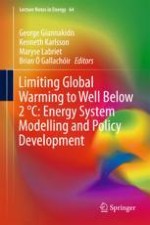2018 | OriginalPaper | Chapter
Pathways to Post-fossil Economy in a Well Below 2 ℃ World
Authors : Antti Lehtilä, Tiina Koljonen
Published in: Limiting Global Warming to Well Below 2 °C: Energy System Modelling and Policy Development
Publisher: Springer International Publishing
Activate our intelligent search to find suitable subject content or patents.
Select sections of text to find matching patents with Artificial Intelligence. powered by
Select sections of text to find additional relevant content using AI-assisted search. powered by
